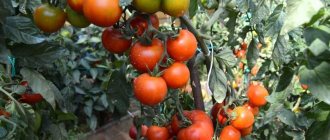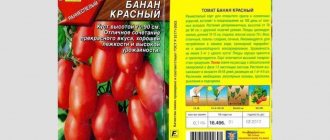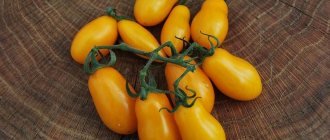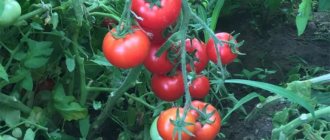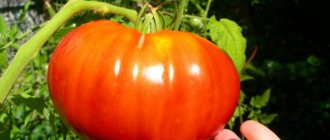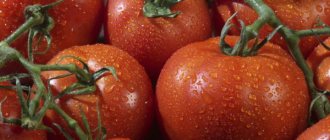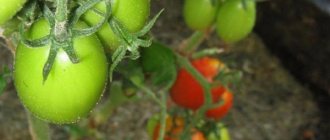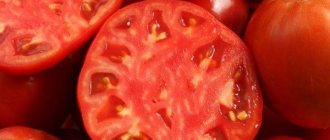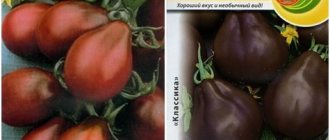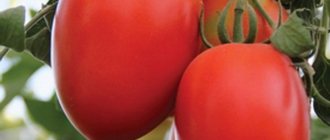general information
Since the market is full of bags of “dates,” people naturally buy them. Moreover, the sown seeds and grown plants of some produce good yields of tasty and sweet tomatoes, which are quite satisfactory for vegetable growers, while others leave much to be desired.
Perhaps someday they will conduct variety tests and enter such a “miracle” into the register, but for now we will be content with what “traditional craftsmen” have produced in the field of seed packaging.
Description of the series
If we consider all the possible options for date tomatoes on the market, we can find common features for the entire series:
- Small fruit (up to 50 g);
- Oval, ovoid or obovate shape;
- Abundance of fruits;
- Semi-determinate or indeterminate vegetative form.
Grown tomato-date bushes, if you are lucky enough to become the owner of good seeds, can amaze and delight the vegetable grower with the beauty of their bush. Red and yellow candle tomatoes hang in clusters from sparsely leafed bushes.
These tomatoes are also good in a can. Vegetable growers who love exotic things and know a lot about cooking are constantly looking for interesting forms, and in this regard, dates are quite appropriate.
These varieties are also popular in Europe. Although they are not called dates, small, oval, cocktail tomatoes are present in any meal.
A vegetable plate with colorful tomatoes can decorate any table. Having selected very small tomatoes, you can combine them with olives, which also looks interesting.
Children really like these small tomatoes, both raw and canned.
How to grow seedlings
Growing seedlings begins with sowing seeds in mid-late March, 2 months before planting in the ground.
Seed preparation
Preparation of seed material includes 3 stages:
- Seed rejection. After careful inspection, non-viable specimens are disposed of.
- Checking for emptiness. The seed material is placed in a saline solution for 10 minutes. Only those grains that have sunk to the bottom are left for sowing.
- Seed disinfection. After disinfection, the grains become more resistant to infections and pests. For disinfection, dilute a weak solution of potassium permanganate and place the seeds in it for 30 minutes. They are then washed with running water and dried.
To increase germination, the seeds are soaked for 10 hours in a growth stimulator - for this, not only specialized preparations are used, but also traditional methods, for example, aloe juice or honey water.
Container and soil
The soil is prepared from a mixture of garden soil, peat and river sand in equal proportions. Potassium fertilizers are added to saturate the soil with useful substances. After thorough mixing, the resulting mixture is poured with a hot solution of dark potassium permanganate.
In this way, disinfection is carried out, destroying pathogens. The cooled soil is laid out in planting containers, filling them two-thirds.
Reference. Potassium fertilizers improve metabolism.
You can plant them in a common wooden box or in individual containers. The main thing is not to forget to make small drainage holes at the bottom to drain excess moisture, which causes rotting of the roots.
For disinfection purposes, prepared containers are treated with a manganese solution.
Sowing
The seeds are sown to a depth of 1 cm with a distance of 2 cm from each other, sprinkled with soil on top and lightly compacted. Moisten with a spray bottle with warm, settled water and cover with film to create greenhouse conditions.
The seeded containers are left in a warm and bright room at a temperature of 24 °C. Periodically remove the film for ventilation.
Seedling care
When seedlings appear, the containers are moved to the windowsill. Daylight hours should be at least 13-14 hours. Therefore, it is necessary to take care of additional lighting.
Reference. If there is a lack of light, the seedlings will begin to stretch and weaken.
As the top layer dries out, the soil is moistened with warm, settled water using a shallow watering can. After watering, the soil is loosened superficially with a regular fork or wooden stick.
When two true leaves appear, the seedlings are picked, planted in containers with a diameter of at least 15 cm. After picking, an increased growth of lateral roots occurs and they will be cramped in small containers. When transplanting, only strong and healthy specimens are left for further development.
If growth is weak, then young bushes are fed with liquid fertilizer for tomato seedlings.
Two weeks before planting in the ground, the seedlings are hardened off. This procedure helps them quickly take root in open ground after transplantation. To harden, plants are taken outside during the daytime for 40 minutes. Gradually, the time spent outdoors is increased to 13 hours, while the night temperature is reduced to 13 °C.
"Date red"
Vegetable growers liked the small-fruited red tomato.
Characteristics and description
, which brought this “date” to the market describes the hybrid as semi-determinate. However, the red date tomato f1 is listed in reviews as tall, indeterminate, reaching heights of 180 or even more centimeters. Some, when describing these tomatoes, compare them with an octopus tomato.
When describing the form, it should be said that it is not unambiguous. One bush, and even one tomato bunch can bear fruits of a round classic shape, oval, ovoid and obovate. This feature does not upset vegetable growers at all, since they are easy to calibrate according to their shape.
The size of the tomatoes is also not uniform. At the time of ripening, one tomato can weigh 15 g, another 7-8 g. But in color they will all be of a uniform, scarlet, rich color.
When cut, two nests with small seeds are clearly visible. The seed nests are not filled with pulp, and the juice is almost clear.
The skin of the fruit is very delicate, thin, but at the same time strong and well keeps the pulp from cracking. The fruits also respond very well to temperature treatments and do not crack under the influence of boiling water.
Tomato fruits are collected in brushes. Harvesting can be done with brushes, since ripening occurs evenly, and all fruits have approximately the same degree of ripeness.
The taste of tomatoes deserves special praise. The fruits are sweet, rich tomato taste and pleasant tomato aroma.
Advantages and disadvantages
Among the advantages, vegetable growers identified the following:
- high productivity;
- good disease resistance;
- excellent taste;
- good keeping quality;
- The shape of the fruit is interesting.
The disadvantage of the variety can be considered mis-grading. However, this is most likely a human factor rather than a property of the variety.
Tomatoes: advantages and disadvantages
The main advantages of this hybrid:
- Decorative appearance of the bush and beautiful exterior of the fruit;
- Great taste;
- Strong immunity;
- Universal cultivation;
- Resistance to short-term frosts.
The disadvantages of Date Yellow include:
- Thermophilia. In southern regions with stable and long summers, the yield of the hybrid increases significantly;
- Requirements for watering and soil nutrition.
"Date yellow"
Oval yellow tomatoes are beautiful on the bush and on the plate.
Description of the variety
The Yellow Date tomato has a semi-determinate bush. Plant of mid-late ripening period. The foliage is weak, and the leaf blade itself is small and light green.
The fruits are not large, equal in size and shape. Oval small cream weighs up to 20 g. Tomatoes are tied in simple sour, 6-8 pieces each.
When cut, two nests filled with rich pulp are visible.
The taste of tomatoes is very rich, sweet, without being cloying.
Advantages and disadvantages
Tomato is very popular among vegetable growers. Among its advantages:
- Productivity;
- Interesting taste with sweetness;
- Disease resistance.
Vegetable growers note the late ripening of fruits as a disadvantage.
Resistance to diseases and pests
Tomato is very disease resistant. There is not a single review that says that his tomato bushes were “attacked” by late blight or bacterial diseases.
The yellow date is insensitive to changes in temperature and environmental humidity and bears fruit well.
Features of growing the variety
There are no particular difficulties in growing this “date”. Like all semi-derminant varieties, it needs support and tying.
The formation of shoots is carried out in 2-3.
Harvesting and application
A long fruiting period is an important advantage of almost all Date tomato varieties. Naturally, in greenhouse conditions it takes longer to collect ripe fruits. Tomatoes are a great addition to fresh salads. The fruits are canned (pickled, pickled) and frozen.
Typically, harvesting begins in July and ends in September. The clusters bear 6-20 small fruits (determined by the Date tomato subspecies). Tomatoes on a bunch ripen at the same time and are firmly attached by the stalk. Therefore, usually when harvesting, individual fruits are not picked, but the cluster is cut off completely. Tomatoes do not crack, are well stored and transported.
"Siberian date"
What variety of tomatoes was so named remains a mystery, but the Siberian Date tomato f1 leaves positive reviews if it is from.
Characteristics and description
This tomato has a determinate bush. Ripening begins quickly - the tomato is early ripening. In the garden, the height of the bush will be within 60-70 cm, but in a limited space it will not stretch above 50 cm. The tomato shoot is elastic, dense, it holds a large number of fruits well.
Tomatoes weigh about 20 grams. They ripen together, and the bush is quickly covered with plum-shaped tomatoes. If the vegetable grower does not have time to harvest the crop, he may well hang on the bushes until the tomatoes are harvested. The shoots hold the crop tightly, and sometimes it is necessary to pick it off with the stalk and whole bunches.
Reviews about the taste of the fruit indicate that the sugar content in tomatoes is very high, and the balance of organic acids combines very organically with sugars.
The wonderful sugar content is also reflected in the taste of tomatoes that were preserved in marinades. Such tomatoes are dense, tasty, sweet and without cracks.
Advantages and disadvantages
The Siberian Date tomato has a number of advantages:
- early maturation;
- high productivity;
- excellent taste properties;
- amicable maturation;
- good keeping quality of fruits;
- universal use;
- ability to grow in limited space.
Features of growing the variety
Experienced vegetable growers, knowing that early ripening tomatoes do not grow their seedlings, but sow them directly into tubs. If the seeds germinate well, then the seedlings are thinned out at the stage of two true leaves. The excess is planted in the garden, and some is left in a tub. Leaving 25-30 cm between the plants, after a while they close together and form a beautiful composition.
The main concern when growing “Siberian Date” comes down to:
- fertilizing;
- watering;
- loosening the soil;
- mulching if necessary.
Growing and care
For 1 sq. m beds plant no more than 3 strong tall bushes.
Agricultural technology is simple, but requires compliance with certain rules:
- watering at the rate of 2–4 liters per 1 bush, the frequency of the procedure is 2–3 times a week;
- installation of posts, supports, gartering;
- fertilizer - once every 2 weeks, using root and foliar methods.
Stepsons are carried out regularly; it is possible to preserve three stepsons for further formation of ovaries.
"Sweet date"
Since there are no date varieties in the register, experienced businessmen solve the problem in their own way. This is not always a bad thing, but vegetable growers get confused about varieties and hybrids.
Vegetable growers, growing the “Sweet Date” tomato, the description of which completely coincides with the “Cherriliza F1” hybrid, came to the conclusion that this is the brainchild of Moscow, Russia.
The hybrid was entered into the register in 2010 and recommended for growing under film covers.
Characteristics and description
The tomato has a salad purpose and is also suitable for whole-fruit canning. Early ripening, it quickly produces an intermediate type inflorescence and bears wonderful fruits.
The plant is tall and indeterminate. The leaf is dark green in color and completely small.
The fruits are cylindrical, smooth, dense, elastic, bright orange in color. The weight of one fruit is from 8 to 10 g. The fruits are identical, equal in length and width. Each brush bears 18-20 fruitlets, which look lovely.
Description of tomato Date yellow F1, reviews, photos
A mid-late tomato hybrid of stunning beauty and productivity for greenhouses and open ground.
The plant is of a semi-determinate type, weakly leafy, high . Requires gartering to the support and pinning. The best results were obtained when forming a plant with 3 or 4 stems. Gardeners from the southern regions often plant a bush only up to the first cluster. Thanks to the frequent arrangement of clusters and excellent fruit set, the plant is literally strewn with bright, shiny tomatoes and has an indescribably attractive appearance.
Fruit characteristics
The fruits are oval creamy, dense, smooth, glossy, golden yellow in color at maturity, do not crack in any weather (the skin is dense). These tomatoes are very good for decorating dishes, as well as for all types of preservation and fresh consumption. The average fruit weight is 20 grams .
The hybrid has extended fruiting - it begins to ripen in August and bears fruit until late autumn.
The fruits have good keeping quality and can last up to 2 months, maintaining their presentation.
"Date orange"
Very similar to a sweet date, but unlike it, the “Orange Date” tomato is a late-ripening tomato.
Characteristics and description
The tomato is intended for cultivation both in film greenhouses and in open ground.
The variety is tall, indeterminate, carpal. One cluster bears up to 20 fruits, uniform in shape and size, weighing up to 20 g.
The fruits of this tomato are bright, rich, orange-amber in color, and oval in shape.
Taste characteristics are rated “excellent”. Balanced sugar and acidity, pleasant notes in taste and aroma, long aftertaste, all this makes the tomato desirable for growing again and again.
The core of the tomato fruit has no voids. The seeds are small, the skin is thin, but does not allow it to burst during bad weather and heat treatments.
Advantages and disadvantages
The variety is very good for growing, it has:
- excellent taste;
- beautiful colour;
- high productivity;
- excellent keeping quality of fruits;
The disadvantage can be called:
- late ripening;
- the need for formation;
- need for garters.
Resistance to diseases and pests
Tomato behaves very well in a greenhouse. But there is no specific data on the variety’s resistance to diseases in open ground.
To avoid damage to tomatoes during the growing season, it is better to apply a series of preventive sprays.
Using modern fungicidal preparations, you can easily prevent the spread of fungal infection. It is better to carry out the first spraying at the moment of formation of the initial ovary, and then at intervals of 15-20 days.
Experienced vegetable growers recommend changing 3-4 fungicidal preparations per season; this will not allow microscopic fungi and their spores to mutate and adapt to chemical preparations.
Nuances for open ground and greenhouses
When growing tall tomatoes in open ground, you can use a horizontal trellis. In greenhouses, the optimal support option is a vertical trellis - it is easier to attach rope garters to the frame.
The Date tomato is slightly affected by tomato diseases (late blight, white and gray rot). But when growing in greenhouse conditions, more attention is paid to prevention:
- at the end of the season, the top fertile layer of soil is renewed;
- the soil in the greenhouse is constantly loosened and the beds are mulched;
- the building is regularly ventilated and watered according to a certain schedule.
When watering bushes in open beds, you need to take into account weather conditions: in rainy times, watering is reduced, the beds are loosened more often and always covered with mulch.
